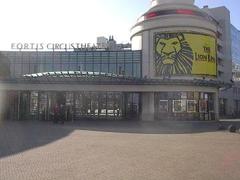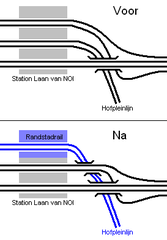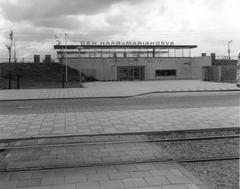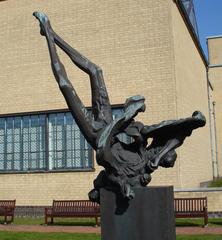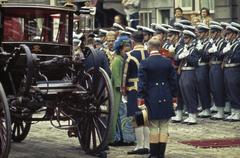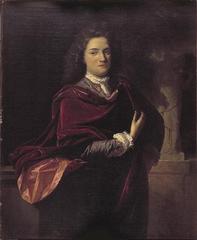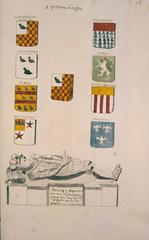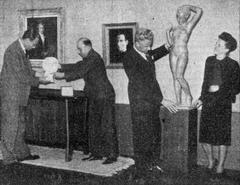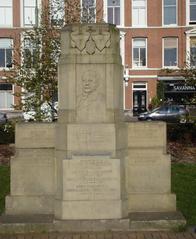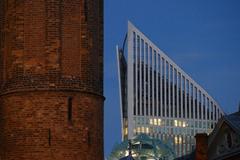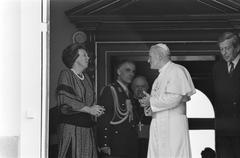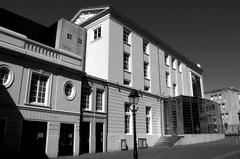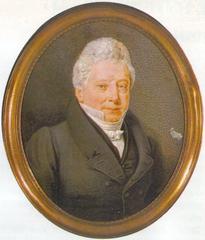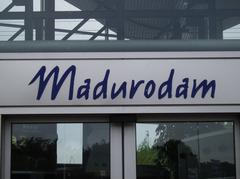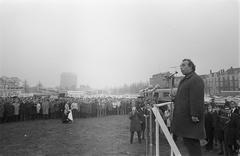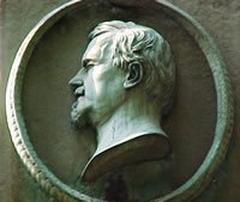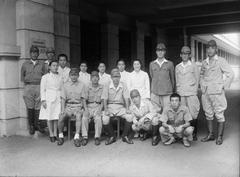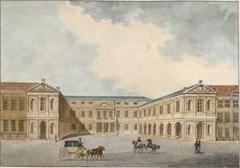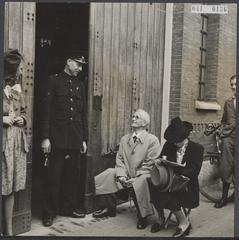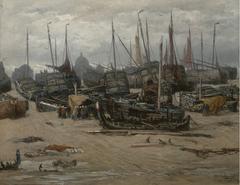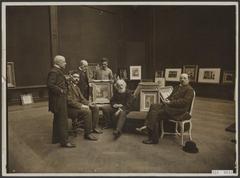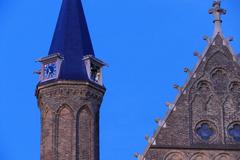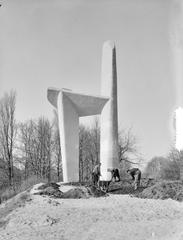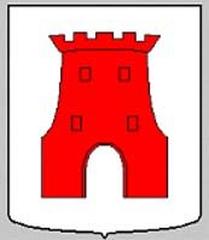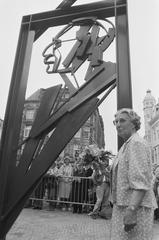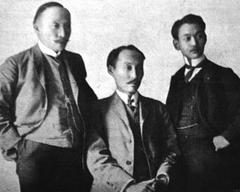
Court Chapel (Hofkapel) The Hague: Visiting Hours, Tickets, and Historical Guide
Date: 04/07/2025
Introduction
The Court Chapel, known locally as the Hofkapel, is a historic and architectural treasure nestled within The Hague’s renowned Binnenhof complex. Dating back to the late 13th century, the chapel is a testament to the Netherlands’ royal, political, and religious history. Although its interior is not regularly open to the public today, the Hofkapel remains a significant symbol of Dutch heritage, offering visitors a chance to connect with the city’s royal and parliamentary roots (Den Haag History).
This guide provides a comprehensive overview of the Court Chapel’s origins, architectural evolution, cultural significance, and practical tips for visitors, including information on nearby attractions, accessibility, and how to experience the chapel and its surroundings.
Table of Contents
- Introduction
- Origins and Early History
- Architectural Evolution and Features
- Role in Dutch Royal and Political Life
- Reformation and Religious Transformation
- 19th and 20th Century Developments
- Visiting the Court Chapel: Hours, Tickets, and Tips
- Preservation and Public Access
- Cultural and Symbolic Significance
- Frequently Asked Questions (FAQ)
- Conclusion and Travel Recommendations
- References
Origins and Early History
The Court Chapel’s story begins in the 13th century, when The Hague transitioned from a rural settlement into the administrative heart of Holland. Commissioned by the Counts of Holland, the chapel was constructed within the Binnenhof as a private sanctuary for the ruling elite—symbolizing the deep ties between faith and governance in medieval Europe (Den Haag History).
Architectural Evolution and Features
Exterior and Setting
The Hofkapel’s architecture represents the restrained Gothic style typical of Dutch ecclesiastical buildings from the late 1200s. Its pointed arch windows, narrow nave, and locally sourced brickwork reflect both functionality and the aesthetic values of the era. The chapel’s modest exterior stands in harmonious contrast to the grand Ridderzaal (Knight’s Hall) nearby, while its setting within the Binnenhof places it among the most politically significant buildings in the Netherlands (Wikimedia Commons: Hofkapel, The Hague).
Interior and Modifications
Historically, the chapel featured a single nave, ribbed vaults, and stained glass windows. Over time, Renaissance and Baroque elements were added, particularly in the interior, following broader artistic trends. The 14th century saw the addition of a chapter house and other spaces for clergy, reflecting its growing importance. Relics such as a fragment of the True Cross and a thorn from the Crown of Thorns were once housed here—gifts from King Charles V of France to Count Albrecht (Wikimedia Commons: Hofkapel, The Hague).
Modern Adaptation
After the Reformation and several centuries of religious and political change, the Hofkapel was repurposed for administrative use. Today, it functions as office space for the Dutch Eerste Kamer (Senate), with its original spiritual role now a part of history.
Role in Dutch Royal and Political Life
The chapel was central to the ceremonial life of the Dutch court, hosting baptisms, weddings, and funerals for the House of Orange-Nassau and other nobility. Its proximity to the Ridderzaal and other governmental buildings made it a locus of both spiritual and state affairs, particularly during the Dutch Golden Age.
Reformation and Religious Transformation
Originally a Catholic sanctuary, the Hofkapel was adapted for Protestant worship after the Dutch Reformation. Catholic imagery was removed in line with Calvinist practices, but the chapel maintained its ceremonial prestige and continued to serve the ruling elite (Den Haag History).
19th and 20th Century Developments
As The Hague expanded and modernized, the daily use of the chapel declined. A fire in 1644 led to significant restorations, and further renovations in the 18th century uncovered graves beneath the floor, including that of Jacqueline, Countess of Hainaut. The discovery of these graves and preserved tombstones underlines the chapel’s role as a royal mausoleum (historyofroyalwomen.com). In the 20th century, The Hague’s emergence as an international city of peace and justice brought renewed attention to the Binnenhof’s historical sites (Stories of Purpose: The Hague).
Visiting the Court Chapel: Hours, Tickets, and Tips
Visiting Hours
The interior of the Court Chapel is not generally open to the public, as it now functions as parliamentary office space. However, the exterior can be admired year-round from the Binnenhof courtyards and the scenic Hofvijver pond. Occasionally, special events or guided tours of the Binnenhof may provide information about the chapel and its history (Den Haag Tourism).
Tickets
There are no tickets specifically for the Court Chapel. Access is typically via guided Binnenhof tours, which often include the Ridderzaal (Knight’s Hall) and displays of preserved tombstones from the chapel. Ticket prices for tours generally range from €5 to €12, and advance booking is recommended, especially during busy periods.
Accessibility and Travel Tips
- The Binnenhof complex is centrally located and easily reached by public transport, bicycle, or on foot from Den Haag Centraal Station.
- The public areas around the Hofkapel, including pathways and viewing platforms, are wheelchair accessible.
- Comfortable footwear is recommended due to cobblestone streets and walking distances between sites.
Nearby Attractions
- Ridderzaal (Knight’s Hall): View preserved tombstones from the chapel and explore Dutch political history.
- Mauritshuis Museum: Renowned for its collection of Dutch Golden Age paintings.
- Peace Palace: Symbol of The Hague’s international role in law and justice.
- Hofvijver Pond: Offers picturesque views of the Binnenhof and the chapel’s exterior.
Special Events and Guided Tours
While interior access to the Hofkapel is rare, special events, exhibitions, and guided tours of the Binnenhof may provide historical insights and occasional glimpses of the chapel’s past. Check official tourism resources for current schedules.
Preservation and Public Access
The Court Chapel is a protected monument, with ongoing restoration and conservation efforts preserving its structure and artistic heritage. Public access is limited to ensure its preservation, but key artifacts—such as tombstones—are displayed in the Ridderzaal for educational purposes.
Cultural and Symbolic Significance
As a landmark of The Hague’s royal and parliamentary history, the Court Chapel embodies the city’s evolution from medieval court to modern seat of governance. Its architectural features, burial sites, and historical uses illustrate centuries of Dutch cultural and political development.
Frequently Asked Questions (FAQ)
Q: What are the Court Chapel visiting hours?
A: The chapel interior is not open to the public, but its exterior can be viewed year-round. Guided Binnenhof tours may include information about the chapel.
Q: Are tickets required to visit the Court Chapel?
A: No tickets are needed for the chapel itself; tickets are required for guided Binnenhof tours, which may reference the chapel.
Q: Is the Court Chapel wheelchair accessible?
A: The surrounding courtyards and viewing areas are accessible, but there is no public access to the chapel’s interior.
Q: Can I see historical artifacts related to the Court Chapel?
A: Yes, select tombstones and artifacts are exhibited beneath the Ridderzaal within the Binnenhof complex.
Q: Are virtual tours available?
A: During renovation periods or restricted access, virtual tours and museum exhibitions featuring the chapel may be found through official tourism and museum websites.
Conclusion and Travel Recommendations
The Court Chapel (Hofkapel) stands as a powerful symbol of The Hague’s history—bridging the city’s medieval, royal, and political past. Although direct access to the chapel is limited, its exterior and the artifacts preserved within the Ridderzaal provide valuable insights into Dutch heritage. Visitors are encouraged to join guided tours, explore adjacent landmarks, and utilize digital resources for a fuller understanding of this unique site. The chapel’s presence, alongside The Hague’s many cultural institutions, affirms the city’s enduring status as the Netherlands’ administrative and historical heart.
For current updates on tours, accessibility, and events, consult official tourism websites and consider using the Audiala app for real-time information.
References
- Den Haag History
- Wikimedia Commons: Hofkapel, The Hague
- Stories of Purpose: The Hague
- historyofroyalwomen.com
- Den Haag Tourism

























